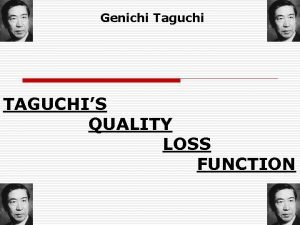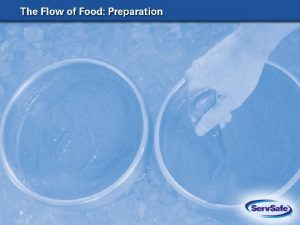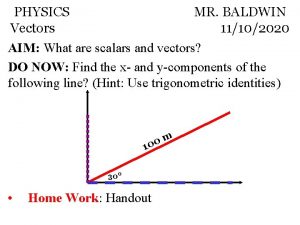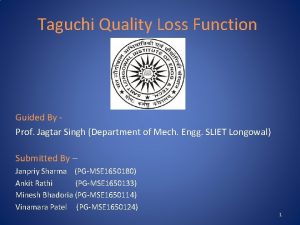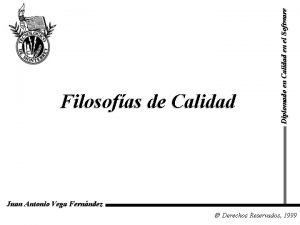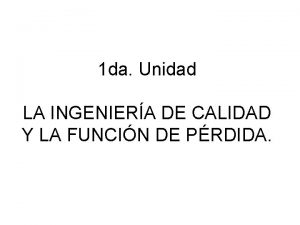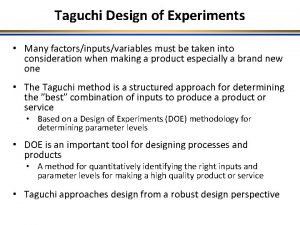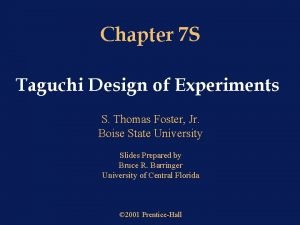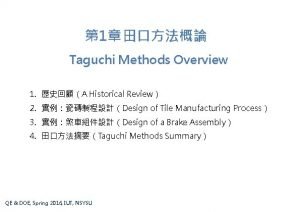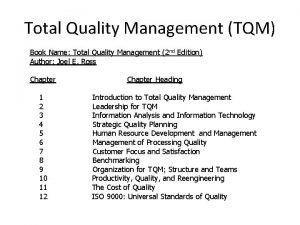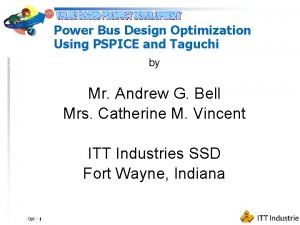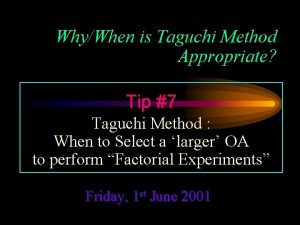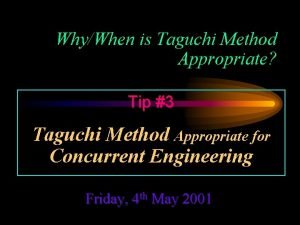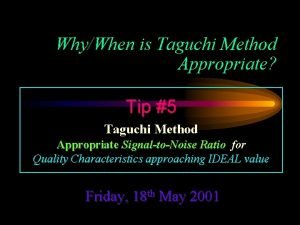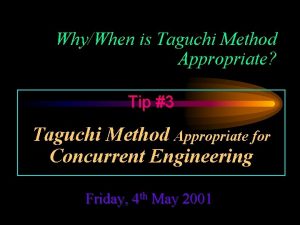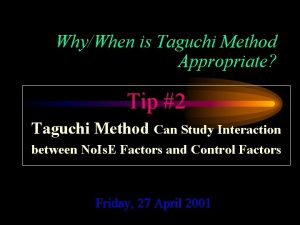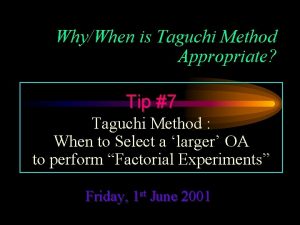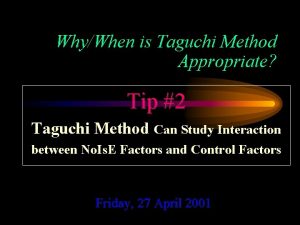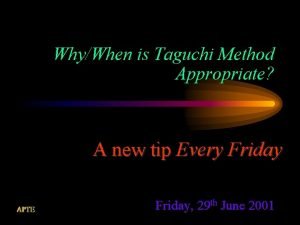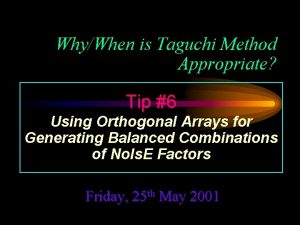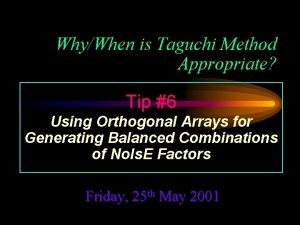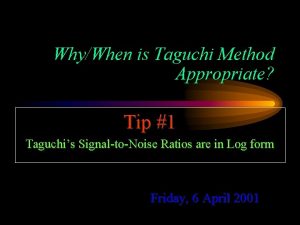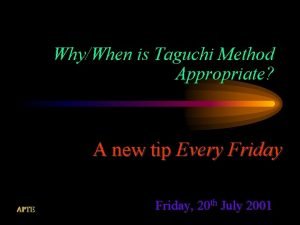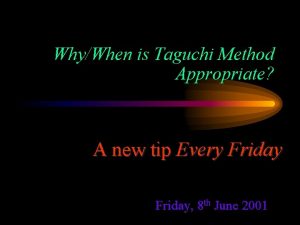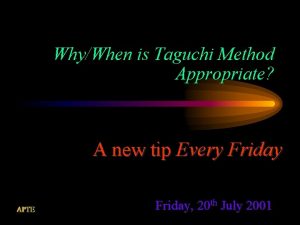WhyWhen is Taguchi Method Appropriate Tip 5 Taguchi















- Slides: 15

Why/When is Taguchi Method Appropriate? Tip #5 Taguchi Method Appropriate Signal-to-Noise Ratio for Quality Characteristics approaching IDEAL value Friday, 18 th May 2001

Tip #5 Taguchi Method Appropriate Signal-to-Noise Ratio for Quality Characteristics approaching IDEAL value (next 7 slides) Friday, 18 th May 2001

Taguchi’s SN Ratio Quality Characteristics approaching IDEAL value • Taguchi’s SN-Ratio for smaller-the-better – quality characteristics is usually an undesired output, for example • Defects like pin holes, particulates in deposition processes • Unwanted by-product or side effect • Taguchi’s SN-Ratio for LARGER-THE-BETTER – quality characteristics is usually a desired output, for example • Bond strength • Critical Current • Taguchi’s SN-Ratio for NOMINAL-the-best – quality characteristics is usually a nominal output, for example • most parts in mechanical fittings have nominal dimensions • Ratios of chemicals or mixtures are nominally the best type. • Thickness should be uniform in deposition /growth /plating /etching. .

Taguchi’s SN Ratio Quality Characteristics approaching IDEAL value • But what about quality characteristics that approach an ideal value? – Examples are • Efficiency : all efficiencies approach the ideal value of 100% • Weld strength : approaches the ideal strength of the material • Critical temperature or Critical current density for High Temperature superconductors (YBCO) : These approach ideal values, say 92 K and 108 A/cm 2 • Which SN-Ratio is most suitable among the following ? – smaller-the-better – LARGER-THE-BETTER – NOMINAL-the-BEST

Taguchi’s SN Ratio Quality Characteristics approaching IDEAL value • Taguchi’s SN-Ratio for smaller-the-better ( quality characteristics is usually an undesired output, say Defects ) – S/N Ratio = – 10 Log 10 ( 1/n Y 2 i ) • Taguchi’s SN-Ratio for LARGER-THE-BETTER ( quality characteristics is usually a desired output, say Current ) – S/N Ratio = – 10 Log 10 ( 1/n 1/Y 2 i ) • Taguchi’s SN-Ratio for NOMINAL-the-best ( quality characteristics is usually a nominal output, say Diameter ) – S/N Ratio = 10 Log 10 ( 2 / 2 )

Taguchi’s SN Ratio Quality Characteristics approaching IDEAL value • Generally, we would state that this value should be “LARGER-THE-BETTER” • However, there exists an IDEAL value!!! • QUESTION still IS “Which SN-Ratio is most suitable among the following ? ” – LARGER-THE-BETTER – smaller-the-better – Nominal-the-best

Taguchi’s SN Ratio Quality Characteristics approaching IDEAL value • Reword the SN-Ratio for smaller-the-better to indicate ‘the approach to IDEAL value’ by saying “Smaller-the-difference-from-IDEAL-the-better” • Taguchi’s SN-Ratio for smaller-the-better is now modified ( for quality characteristics approaching IDEAL output ) – S/N Ratio = – 10 Log 10 [ 1/n (YIDEAL- Y ) 2 ] i

Taguchi’s SN Ratio Quality Characteristics approaching IDEAL value • If our nominal values are far away from IDEAL value – SN-Ratio for LARGER-THE-BETTER will give good additivity (prediction and results will match well) • If our nominal values are already close to IDEAL value – SN-Ratio for smaller-the-better (the modified form) will give good additivity (prediction and results will match well) = – 10 Log 10 [ 1/n (YIDEAL- Y ) 2 ] i

Taguchi’s SN Ratio Quality Characteristics approaching IDEAL value • SN-Ratio for LARGER-THE-BETTER tends to predict optimistic (LARGER) values – Sometimes the value exceeds maximum possible value !? • SN-Ratio for smaller-the-better (the modified form) always predicts values pessimistically (LESS than ideal value) ü TRY BOTH, Select one with less ANOVA error Friday, 18 th May 2001

More Tips 16. Links below Taguchi Method e 1 st Priority : Va ia ce R duction 2 nd Priority : Factor Effects Friday, 3 rd Aug 2001 15. “inner” L 9 array with “outer” L 4 and L 9 No. Is. E arrays Friday, 27 th July 2001 14. Taguchi Method r n “inner” L 18 array with “outer” L 4 and L 9 No. Is. E arrays 13. Friday, 20 th July 2001 Taguchi Method Why/When is Taguchi Method not Appropriate? Friday, 13 th July 2001 Tips 12, 11, 10

More Tips 12. Taguchi Method Links below Friday, 6 th July 2001 “inner” L 8 array with “outer” L 4 and L 9 No. Is. E arrays 11. Taguchi Method Friday, 29 th June 2001 Useful at ALL Life-stages of a Process or Product 10. Taguchi Method Friday, 22 nd June 2001 Performs Process “centering” or “fine tuning” Tips 9, 8, 7

More Tips 9. Taguchi Method Links below Friday, 15 th June 2001 Identifies the “right” No. Is. E factor(s) for Tolerance Design 8. Taguchi Method Friday, 8 th June 2001 Finds best settings to optimize TWO quality characteristics Simultaneously 7. Taguchi Method Friday, 1 st June 2001 When to select a ‘Larger’ OA to perform “Factorial Experiments” Tips 6, 5, 4

More Tips 6. Taguchi Method Links below Friday, 25 th May 2001 Using Orthogonal Arrays for Generating Balanced Combinations of No. Is. E Factors 5. Taguchi Method Friday, 18 th May 2001 Signal-to-Noise Ratio for Quality Characteristics approaching IDEAL value 4. Taguchi Method Friday, 11 th May 2001 improves " quality “ at all the life stages at the design stage itself Tips 3, 2, 1

More Tips Links below 3. Taguchi Method Appropriate for Concurrent Engineering Friday, 4 th May 2001 2. Taguchi Method can study Interaction Friday, 27 th April 2001 between Noise Factors and Control Factors 1. Taguchi’s Signal-to-Noise Ratios are in Log form Friday, 6 th April 2001

end
 Sıcak evin direği tıp tıp eder yüreği
Sıcak evin direği tıp tıp eder yüreği Taguchi loss function formula
Taguchi loss function formula What are the four acceptable methods for thawing food?
What are the four acceptable methods for thawing food? Cell cycle
Cell cycle Vector addition formula
Vector addition formula Taguchi quality loss function
Taguchi quality loss function Taguchi array selector
Taguchi array selector Dr. genichi taguchi
Dr. genichi taguchi Definicion de calidad de deming
Definicion de calidad de deming Taguchi array selector
Taguchi array selector Funcion de perdida de taguchi ejemplos
Funcion de perdida de taguchi ejemplos Taguchi design of experiments
Taguchi design of experiments Thomas taguchi
Thomas taguchi Genichi taguchi
Genichi taguchi Genichi taguchi contribution to quality management
Genichi taguchi contribution to quality management Taguchi
Taguchi

